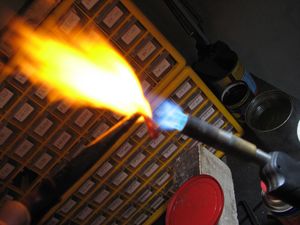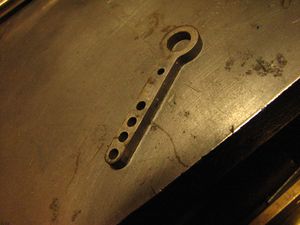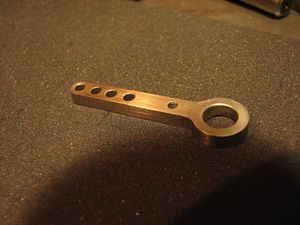Case hardening
Case hardening or surface hardening is the process of hardening the surface of a metal object while allowing the metal deeper underneath to remain soft, thus forming a thin layer of harder metal (called the "case") at the surface. For iron or steel with low carbon content, which has poor to no hardenability of its own, the case hardening process involves infusing additional carbon into the case. Case hardening is usually done after the part has been formed into its final shape, but can also be done to increase the hardening element content of bars to be used in a pattern welding or similar process. The term face hardening is also used to describe this technique, when discussing modern armour.
Because hardened metal is usually more brittle than softer metal, through-hardening (that is, hardening the metal uniformly throughout the piece) is not always a suitable choice for applications where the metal part is subject to certain kinds of stress. In such applications, case hardening can provide a part that will not fracture (because of the soft core that can absorb stresses without cracking) but also provides adequate wear resistance on the surface.
Carburizing
Carburizing is a process used to case harden steel with a carbon content between 0.1 and 0.3 wt% C. In this process steel is introduced to a carbon rich environment and elevated temperatures for a certain amount of time, and then quenched so that the carbon is locked in the structure; one of the simpler procedures is repeatedly to heat a part with an acetylene torch set with a fuel-rich flame and quench it in a carbon-rich fluid such as oil.
Carburization is a diffusion-controlled process, so the longer the steel is held in the carbon-rich environment the greater the carbon penetration will be and the higher the carbon content. The carburized section will have a carbon content high enough that it can be hardened again through flame or induction hardening.
It is possible to carburize only a portion of a part, either by protecting the rest by a process such as copper plating, or by applying a carburizing medium to only a section of the part.
Small items may be case hardened by repeated heating with a torch and quenching in a carbon rich medium, such as the commercial products Kasenit / Casenite or Cherry Red. Older formulations of these compounds contain potentially toxic cyanide compounds, while the more recent types such as Cherry Red do not.
Tempering
Tempering is a process of heat treating, which is used to increase the toughness of iron-based alloys. Tempering is usually performed after hardening, to reduce some of the excess hardness, and is done by heating the metal to some temperature below the critical point for a certain period of time, then allowing it to cool in still air. The exact temperature determines the amount of hardness removed, and depends on both the specific composition of the alloy and on the desired properties in the finished product. For instance, very hard tools are often tempered at low temperatures, while springs are tempered to much higher temperatures. In glass, tempering is performed by heating the glass and then quickly cooling the surface, increasing the toughness.
See Hardening and Tempering Colors.
Procedure
Jim Kreider posted the following Facebook, 1 April 2020:
- Some of the parts that you will make while building a live steam locomotive will be made out of ordinary soft carbon steel. They will require at least a case-hardening treatment before they are applied to the locomotive to make sure that they will wear well during use.
- One part that comes to mind is the throttle lever quadrant. I had these parts laser cut. With all those little teeth on the quadrant the laser had to cut maybe three teeth, go to another section of the quadrant, and then come back where it left off to avoid overheating and burning off those small teeth in a given area.
- A process to case harden that I have used in the past with success is to use “case-hardening powder”
- Jack Bodenmann describes the process quite well;
- When case hardening you should wear gas welding glasses. First, heat the work piece to dull red heat. Then immerse the work piece in Kasenit, or Cherry Red. The case hardening powder will then stick to the work piece. Then bake the part at red heat for a couple minutes with the oxygen acetylene torch. You may have to re coat it. As the part will incandesce brightly while being heated, you should do this while looking through the dark glasses. When doing this have the glasses hanging on the end of your nose so that when you take the torch away from the work piece, you can look over the top of the glasses and check the heat. Be careful not to overheat the part. Re coat the part with the case hardening powder and repeat the baking process for another minute or so. Then while the part is still at red heat quench it in cold water. Its hard to judge the heat of the part with the dark glasses on. So that’s the reason for having them down on your nose so you can look over them when you take the torch away. You should also have a nice finish on the part before hardening. After hardening you should check the part with a file. The file should glide over the part without cutting. This is a very handy process and I often use it on the pins in a throttle linkage. With phosphor bronze bushing and carefully fitted hardened pins a throttle linkage will have no lost motion and will remain that way.
Andrew Matthews posted on Facebook, 1 April 2020:
- For smallish parts I find the MAPP gas flame an ideal temperature for case hardening, keeping the part nice and hot without burning it.
Adam Wright posted on Facebook, 1 April 2020:
- Two counterpoints to add:
- 1. If you are having steel laser cut, due to the Heat Affected Zone, you already have a localized case-hardened teeth on the quadrant.
- 2. If you make the parts out of a heat treatable alloy (like AISI 4140) then carburizing is unnecessary. Just heat and quench. Draw the temper if desired.


